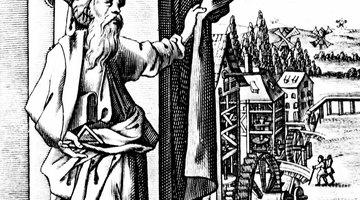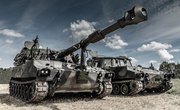The catapult is an ancient war machine and a siege weapon used in ancient and medieval times. In Greek, the word catapult means "to throw into." Catapults used tension, torsion and gravity to throw heavy projectiles at enemy targets and could hurl large stones of up to 500 pounds more than 300 feet. The first historical evidence of the use of catapults in war comes from 400 B.C. in the Greek city of Syracuse.
Catapult History in Ancient Greece
Dionysius the Elder of Syracuse, who wanted to develop a new kind of weapon, designed the catapult in about 400 B.C. The first catapult was made like a large crossbow set on a tripod. Two hundred years later, the Greek scientist and mathematician Archimedes used mathematical principles to refine the construction, making a catapult that could throw much heavier projectiles than the original one.
In 214 B.C., King Hiero asked Archimedes to develop weapons to help fight the Roman army led by Marchellus that attacked Syracuse by both land and sea. To help King Hiero, Archimedes improved the catapult design, creating a catapult that could hurl 500-pound boulders at the attacking soldiers, causing severe damage to the enemy's army. His other inventions included large claws that could lift the enemy’s ships and smash them against the rocks and mirrors that magnified the sun’s rays and set on fire the sails of the enemy’s ship. These weapons kept the Roman army besieging Syracuse at bay for two years.
How Does a Catapult Work?
A catapult is a simple machine that has a long wooden beam that rotates along a horizontal axis. The wooden beam has a spoon/bucket attachment at the top end where the projectile is placed. When the arm rotates, it makes use of stored energy to release the projectile. The angle at which the projectile is launched is controlled by a crossbar, which is positioned at a certain distance from the top end of the arm to stop it from rotating.
What Are the Three Types of Catapults?
There are actually three types of technologies that fall under the category of catapult: ballista, trebuchet and catapult. When most people think of a catapult, they imagine the construction with a single long arm that rotates and throws a projectile into the air. Mangonel and onager are two kinds of this traditional catapult. Both of these catapults launch their projectiles by rotating the beam at a high speed and throwing the load out. The difference between a mangonel and an onager is the attachment at the top of the arm. In a mangonel, projectiles were placed in a bowl-shaped bucket, while in an onager, they were thrown from a sling. Although this type of catapult has a lot of power, it is actually less accurate than the other two types.
The second type of catapult is called a ballista. It looks like an oversized crossbow and functions in the same way. The ballista used a built-up tension in the rope to throw oversized arrows and other projectiles toward the enemy. It is less powerful than the catapult but is a lot more accurate.
The trebuchet is the most efficient and accurate type of catapult, and it was used a lot in the Middle Ages. It uses gravity to provide propulsion energy. Specifically, it uses a heavier counterweight to launch projectiles into the air. It is set up like a seesaw with the pivot point much closer to the front end where the counterweight is located than to the payload at the rear. The projectile can reach quite a high velocity when the ratio of the lengths of the lever arms is great.
Related Articles
References
Writer Bio
Tanya Mozias Slavin is a former academic and language teacher. She writes articles about education and linguistic technology, and has published in the Washington Post, Fast Company, CBC and other places. Find her at www.tanyamoziasslavin.com











